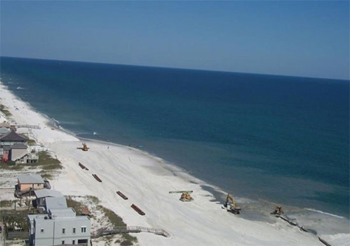It’s your money and not just sand eroding away on the shore.
By J. Siry
The seashore, since colonial times, has belonged to all
citizens. Yet there are few other more contested grounds on earth where the clash of interests make for some of the costliest and ecologically damaging decisions than on this densly settled and shrinking margin between the sea and the land. There is no older heritage for Americans than our access to the shores, where the tides ebb and
flood. Beaches--that are so definitive of Florida's seashores--are the state’s
property, held in trust for all people. Called sovereign lands, these tidally
submerged shorelines are owned by no one, but used by anyone to fish, hunt or
enjoy the wild outdoors.
Because the sea is forever changing, long-shore currents
sweep sand along the coast. Storms eat away at beaches and move the dunes from
one place depending on the prevailing winds, storms and surf. The world’s
barrier islands are not stable, and Florida’s are no exception. Sand
moves, dunes and their tenacious vegetation protect the land from erosion, and
there is no cheap or easy way to anchor a moving island.
 That has not stopped the Army Corps of Engineers, at the
behest of upland property owners and state legislatures, to replace sand that
inevitably moves away from where it was replenished. Beach sand will erode away
due to storms; indeed as sea level is rising, the entire island will eventually
shift ever closer to the mainland.
That has not stopped the Army Corps of Engineers, at the
behest of upland property owners and state legislatures, to replace sand that
inevitably moves away from where it was replenished. Beach sand will erode away
due to storms; indeed as sea level is rising, the entire island will eventually
shift ever closer to the mainland.
A good example of private property owners who want the
public to pay for beaches in what we call, coastal high-hazard areas, characterizes
the current debate over putting sand back on  Florida’s beaches. Shorebirds
and female marine turtles nest on shifting beaches where the dunes and sea --in
an uneven standoff-- sit face to face. Protecting investments along moving
beaches may be a public virtue, may even be a commendable use of taxes, but is
another example of private property owners looking for a government bail out
when they encounter a high risk situation.
Florida’s beaches. Shorebirds
and female marine turtles nest on shifting beaches where the dunes and sea --in
an uneven standoff-- sit face to face. Protecting investments along moving
beaches may be a public virtue, may even be a commendable use of taxes, but is
another example of private property owners looking for a government bail out
when they encounter a high risk situation.
So what is this debate about over moving submerged sand onto
a beach, or digging a deep hole in a channel to let boat owners pass,
unobstructed to the ocean from our many bays? Certainly the appropriate use of
tax revenues is in question. Another matter is who pays for natural changes in
a beach or a shoreline? In what proportion should we pay for keeping nature
from taking the course of least resistance?
Every year, since the 1960s, beach replenishment, as it is
called, occurs due to storms moving sand to“ less desirable” places
along the shore. Taxpayers fund about $100 million annually to restock sand on
Atlantic Coast beaches. From 1996 to 1998 approximately $2.5 billion was spent to
replenish 382 eroded beaches. A study by Pilkey and Trembanis concluded that
subsequent need for more sand increased after these 1,305 “nourishment
episodes” during the period
they analyzed. The economic cost is $5.08 (1999 dollars) for every cubic yard
of sand ($6.49 on the Gulf Coast) placed back on a beach. In five to seven
years it washes away. Additionally, the costs to turtles and shorebirds made homeless
during the process are inestimable. We may all want beaches but we are also unwilling
to pay for them.
519 words
test of conservation and development

Syllabus
Contents of Carson's 1955 book.
overview of The Edge of the Sea.
Other essays:
 That has not stopped the Army Corps of Engineers, at the
behest of upland property owners and state legislatures, to replace sand that
inevitably moves away from where it was replenished. Beach sand will erode away
due to storms; indeed as sea level is rising, the entire island will eventually
shift ever closer to the mainland.
That has not stopped the Army Corps of Engineers, at the
behest of upland property owners and state legislatures, to replace sand that
inevitably moves away from where it was replenished. Beach sand will erode away
due to storms; indeed as sea level is rising, the entire island will eventually
shift ever closer to the mainland. Florida’s beaches. Shorebirds
and female marine turtles nest on shifting beaches where the dunes and sea --in
an uneven standoff-- sit face to face. Protecting investments along moving
beaches may be a public virtue, may even be a commendable use of taxes, but is
another example of private property owners looking for a government bail out
when they encounter a high risk situation.
Florida’s beaches. Shorebirds
and female marine turtles nest on shifting beaches where the dunes and sea --in
an uneven standoff-- sit face to face. Protecting investments along moving
beaches may be a public virtue, may even be a commendable use of taxes, but is
another example of private property owners looking for a government bail out
when they encounter a high risk situation.